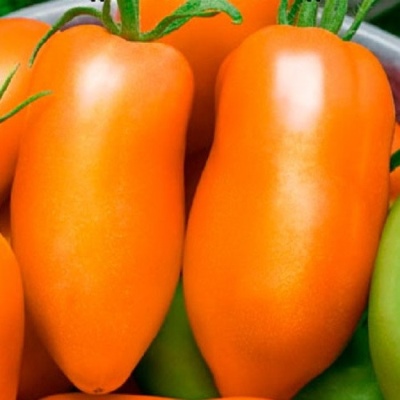
- Authors: Gubko V. N., Kamanin A. A. (Agro-Technological Firm "Agros" LLC, Federal Research Center, Institute of Cytology and Genetics, Siberian Branch of the Russian Academy of Sciences)
- Year of approval: 2007
- Category: grade
- Growth type: indeterminate
- Appointment: universal
- Ripening period: mid-season
- Ripening time, days: 110-115
- Growing conditions: for open ground, for film greenhouses
- Transportability: good
- Bush size: tall
The tomato variety Pepper Orange attracts many. And not only because it is original and beautiful - there are a lot of useful things in the fruits: vitamins, lycopene, carotenoids, and the taste is simply excellent.
Breeding history
Pepper orange is the brainchild of Novosibirsk breeders VN Gubko and AA Kamanin. The work was carried out on the basis of the agro-technological company "Agros" and the Federal Research Center of the Institute of Cytology and Genetics of the Siberian Branch of the Russian Academy of Sciences. After receiving the variety, the application was filed in 2005. Since 2007, the crop has been included in the State Register of the Russian Federation and approved for cultivation practically throughout the country.
Description of the variety
The variety in question is an indeterminate variety, respectively, it is tall, so it needs pinching and a garter. The stems grow in height by 1.5-1.8 meters. Moderate branching and leafiness. On the bush, 7-8 clusters with fruits develop, and each cluster contains from 6 to 8 tomatoes.
The variety has quite a few advantages:
- excellent commercial qualities;
- taste indicators are also excellent;
- high transportability, tomatoes are perfectly stored;
- the variety is resistant to adverse weather factors;
- rich in nutrients composition.
Of the minuses, the need for shaping and feeding is noted. But these are standard procedures, and they hardly should be attributed to disadvantages.
The main qualities of the fruit
The color of the Pepper Orange is expectedly deep orange. The fruits are not very large, rather medium, their weight ranges from 135 to 156 grams, neat elongated shape, it is described as cylindrical, pepper-shaped. There are few seeds in the pulp, 3-4 nests, while the pulp is juicy, but moderately. Cracking resistant skin.
Taste characteristics
Pepper Orange is dominated by sweet, sugary notes.
Ripening and fruiting
The variety ripens 110-115 days after germination, therefore it belongs to mid-season crops. Differs in long-term fruiting. You can enjoy delicious and healthy fruits from July to September inclusive.
Yield
High-yielding variety. The productivity of one "square" is up to 9 kg, and it is possible to collect 4-5 kilograms of tomatoes from one bush.
The timing of planting seedlings and planting in the ground
Seeds of Pepper Orange are required to be sown at the end of February or in the first half of March. Transplantation of seedlings occurs at the age of 50-60 days. Preferably it should be well-lit by the sun and fertile beds.
Seedling soil can be prepared from turf by adding peat, sand and compost to it. It is necessary to leave 2 cm between the seeds, 5 cm between the grooves. To grow good viable seedlings, the crops are watered with settled warm water, fertilized with "Kemira" or "Krepysh", supplemented with phytolamps.

Growing tomato seedlings is an extremely important process, because it largely depends on whether the gardener will be able to harvest at all. All aspects must be taken into account, from seedbed preparation to planting in the ground.
Landing scheme
When planting tomatoes, it is worth adhering to the 60x50 cm scheme, which means that the density of planting grown seedlings in the ground is 3-4 bushes on an area of 1 m2.

Growing and care
Tomato Pepper Orange requires no more care than any other crop. The list of activities includes:
- the formation of the stem in 2 shoots;
- tying to a solid support;
- watering as needed;
- loosening the soil and applying mulch after watering;
- systematic feeding with phosphorus-potassium and organic compounds.




A plant needs different micronutrients at each stage of growth. All fertilizers can be divided into two groups: mineral and organic. Folk remedies are often used: iodine, yeast, bird droppings, eggshells.
It is important to observe the rate and period of feeding. This also applies to folk remedies and organic fertilizers.


Growing regions
The Pepper Orange variety is recommended and bears fruit effectively almost throughout the country. However, it is especially well adapted to growing in central Russia, here it is intended for open ground. In the north, the culture is planted only in sheltering greenhouses.

























































































